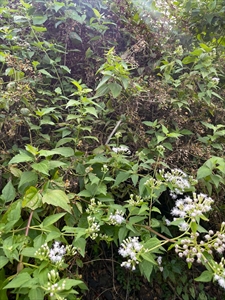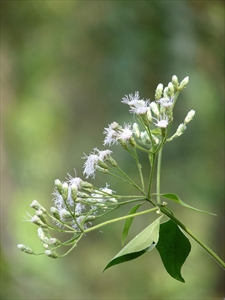Siam weed. It is also known as devil weed and Christmas bush.
Pacific Pests, Pathogens, Weeds & Pesticides - Online edition
Pacific Pests, Pathogens, Weeds & Pesticides
Siam weed (485)
Chromolaena odorata; previously known as Eupatorium odoratum. It is a member of the Asteraceae.
Asia, Africa, North, South and Central America, the Caribbean, Oceania. It is recorded from Australia (Queensland, under eradication), Federated States of Micronesia, Guam, Marshall Islands, Northern Mariana Islands, Palau, and Papua New Guinea. Siam weed is native to South and Central America.
A serious perennial weed, forming dense tangled thickets up to 5 m, where introduced into tropical Asia, Africa and the Pacific (Photos 1&2). It occurs in plantations of cashew, cocoa, coconut, cotton, maize, oil palm, pineapple, rubber, sugarcane, tea, and teak. It is also found in many other habitats, such as areas cleared for planting, neglected fields, wastelands, along roadsides, sometimes along riverbanks and in pastures.
Siam weed grows on many soil types, but prefers well-drain conditions and rainfall over 1000 mm annually. Growth is poor under heavy shade.
Multi-branched, usually about 2.5 m tall, but up to 10 m, with soft, round, yellowish stems, woody at the base. Leaves, 4-10 cm long, triangular to oval, hairy, three-veined, with serrated margins, in opposite pairs along stems on short stalks, 1-4 cm long (Photos 3&4). Crushed leaves have a pungent, aromatic smell. Flowers, white to pale pink, tubular, in a flat-topped cluster at the end of stems (Photo 5). Seeds, 4-5 mm long, narrow, with hooks, and a parachute of white bristles, 5 mm long. Seed production is prolific, up to two million per plant. Root system fibrous and shallow. Enlargement at junction of stem and root is called the 'basal bulb'; this becomes a storage organ, and assists survival during adverse environmental conditions.
Spread is by seeds floating on winds, by water, and clinging by hooks to fur, clothes and machinery. Long distance as a contaminant of forestry and pasture seeds, and soil, sand and gravel. Survival of seed up to 5 years on or in the soil. Plants can regenerate from the basal bulb.
Siam weed has a serious detrimental impact on agriculture and the environment. It grows rapidly, smothering crops, young forestry plantations, pastures and native vegetation threatening biodiversity; its roots produce chemicals that inhibit the growth of nearby plants (allelopathy). In areas with dry seasons, it dies after flowering to become a fire hazard, and later produces shoots forming dense tangled bushes, creating barriers to pastures as well as homes for vermin. The leaves are toxic to cattle, and cause skin allergies to humans if plants are hand-weeded.
It is a traditional medicinal plant, widely used for wound-healing, especially burns and skin infections. Sometimes an ornamental plant. Used in traditional agriculture systems (e.g., shifting cultivation) to compete with the more difficult to control Imperata cylindrica. Said to be a useful organic soil amendment, if composted before seed set.
BIOSECURITY
There is a high risk of introduction of Siam weed. Once established, it is extremely difficult to control. A large amount of seed is produced, and this stays viable for many years. Countries not yet infested by Siam weed (especially in Africa and Oceania) should consider all likely pathways for entry, and apply quarantine measures accordingly. It is a restricted invasive plant under biosecurity acts in some parts of Australia; this means - a person must not release these invasive plants into the environment, give away or sell as a plant or something infested with its seeds.
Chromolaena odorata is on the Global Invasive Species Database (2021) of information on alien and invasive species that negatively impact biodiversity, managed by the Invasive Species Specialist Group of the IUCN Species Survival Commission: (http://www.iucngisd.org/gisd/speciesname/Chromolaena+odorata). It is also among 100 of the World's Worst Invasive Alien Species on the Global Invasive Species Database, maintained by the IUCN Invasive Species Specialist Group, 2020: (http://www.iucngisd.org/gisd/100_worst.php).
BIOLOGICAL CONTROL
Attempts at biological control have been extensive. The moth, Pareuchaetes pseudoinsulata, has become well-established in Guam, Federated States of Micronesia, and Northern Mariana Islands (and in Sri Lanka). However, a number of species of the moth were identified over its range, so it's necessary to match moth, host and environment. More lately, Australia has released the stem-galling fly, Cecidochares connexa, in Queensland and the Northern Territory. It is also released in Indonesia.
CULTURAL CONTROL
It is important to control Siam weed before flowers mature and set seed. Do the following:
- Physical & Mechanical:
- Pull-out plants by hand, making sure to include the 'basal bulb'; a method recommended for small infestations. Do not leave plants or plant pieces in contact with soil: collect and burn. Cover hands when pulling weeds.
- Do not slash or plough infestations as root pieces may spread and regenerate, making the situation worse.
- Use ground or tree legumes:
- Use competitive species: Leucaena leucocephala (see Fact Sheet no. 500), Tephrosia purpurea; ground cover legumes.
- Use competitive species: Leucaena leucocephala (see Fact Sheet no. 500), Tephrosia purpurea; ground cover legumes.
Note, that in all situations it is important to monitor and follow-up with chemical control if necessary.
- Hygiene:
- Treat vehicles and farm machinery. If moving from areas where the weed occurs to those weed-free, wash to remove soil. This is equally important if the machinery is being imported into a country or moved within a country.
- Where the weed is already present, ensure seeds are not carried on clothes between infested and 'clean' areas.
- Quarantine livestock for at least 1 week between moving them from Siam weed-infested areas.
- Do not move soil, sand or gravel from infested to Siam weed-free areas.
- Develop IPM programs using fire - but before seed release - with physical/mechanical clearing and herbicide application.
CHEMICAL CONTROL
Apply herbicides before flowering to prevent the production and spread of seed. The following herbicides are registered in Australia: picloram; fluroxypyr; glyphosate; triclopyr + picloram; triclopyr, picloram + aminopyralid; metsulfuron-methyl; fluroxypyr + aminopyralid. Control is usually best on regrowth after slashing.
--------------------
Note, EU approval to use glyphosate ends in December 2022; its use after that date is under discussion.
____________________
When using a pesticide, always wear protective clothing and follow the instructions on the product label, such as dosage, timing of application, and pre-harvest interval. Recommendations will vary with the crop and system of cultivation. Expert advice on the most appropriate herbicides to use should always be sought from local agricultural authorities.
AUTHOR Grahame Jackson
Information from Waterhouse DF (1994) Chromolaena odorata (L.) R.M. King and H. Robinson. Biological control of weeds: Southeast Asian Prospects. ACIAR Monograph No. 26. Brown Prior Anderson Pty. Ltd. Canberra, Australia; and Chromolaena odorata. Wikipedia. (https://en.wikipedia.org/wiki/Chromolaena_odorata); and CABI (2019) Chromolaena odorata (Siam weed). Crop Protection Compendium. (https://www.cabi.org/cpc/datasheet/23248); and Siam weed (2020) Business Queensland. Queensland Government. (https://www.business.qld.gov.au/industries/farms-fishing-forestry/agriculture/land-management/health-pests-weeds-diseases/weeds-diseases/invasive-plants/restricted); and Siam weed (2020) Chromolaena odorata and Chromolaena squalida. The State of Queensland, Department of Agriculture and Fisheries. (https://www.daf.qld.gov.au/__data/assets/pdf_file/0015/50028/siam-weed.pdf); and from WeedsAustralia (2020) Chromolaena odorata (L.) R.M.King & H.Rob. Weeds Australia Profiles. Centre for Invasive Species Solutions. Atlas of Living Australia. (https://profiles.ala.org.au/opus/weeds-australia/profile/Chromolaena%20odorata). Photo 1 Scott Zona Chromolaena odorata Seacrest Scrub Natural Area, Palm Beach Co., Florida, USA. Photo 2 Scamperdale Chromolaena odorata (L.) R.M.King & H.Rob. (ASTERACEAE). Ashasathees Chromolaena odorata.jpg. Photo 4 2009 Jee & Rani Nature Photography.jpg.
Produced with support from the Australian Centre for International Agricultural Research under project HORT/2016/185: Responding to emerging pest and disease threats to horticulture in the Pacific islands, implemented by the University of Queensland and the Secretariat of the Pacific Community.








